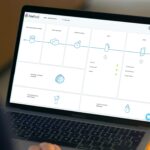The next generation PaaS is here. Nex-gen PaaS for artificial intelligence and analytics. Find out what third-generation PaaS is all about
Cloud computing Platform-as-a-Service (PaaS) for application developers has evolved a great deal over the years. Today developers use third-generation PaaS as their environment to build and deploy web applications without worrying about the underlying cloud infrastructure. Third-generation PaaS provides developers with cost-effective, rapid development, and easy deployment for faster time to market web applications, making it a cloud computing game-changer.
Let’s look at how PaaS has evolved into a cloud computing game-changer.
The first-generation PaaS
The first-generation PaaS provided most of the services developers could benefit from to develop and deploy their web applications. The value proposition was mainly around the commoditization of the web services – computing resources, infrastructure, and data storage. The cloud made renting the compute infrastructure cheaper than buying it.
The companies opting for a first-generation PaaS were still responsible for managing their cloud resources, including scalability, workloads, and security. They were also responsible for choosing, installing, and managing the tools and software needed to build and deploy their web applications. As a result, they found themselves needing an army of Sys Admins and Dev Ops to manage their cloud infrastructure, data, middleware and to take care of the software maintenance and upgrades.
These first-gen offers are comparable to renting a car in a world where you need to build the car from scratch before you can drive it. In this world, you need to choose which car parts you want to rent and assemble them together. If they don’t fit, you need to figure out a way to make them work together by building special connectors or modifying one to make it fit with the other. But, since you don’t have the skills to do it yourself, and since you’re in a hurry, you hire a team of experts to do it for you. It still makes business sense because renting the parts is cheaper than buying them.
The second-generation PaaS
The second-generation PaaS came about when major cloud service providers like Amazon, Microsoft, and Google introduced new tools and software to help users build and deploy their web applications faster. They offered all the components needed, reducing the complexity of choosing parts from different vendors, integrating them, and managing their life cycles.
But using these tools requires hiring specialized skill sets since infrastructure management, which includes managing the proxies, the scheduler, the orchestration, and the security, is still needed. For example, with AWS or Azure, there are several databases and components to choose from, and pricing structures are challenging to understand. Few engineers understand and are good at managing these services. It is simply not a scalable solution for most companies.
Furthermore, the majority of these tools are proprietary and work on one cloud and not another. This leads to migration issues and the risk of vendor lock-in.
To stay with the car analogy above, with the second generation car rental agency, instead of choosing the parts yourself, the agency ships you all the parts you need to build the car. You still need to install them and fit them together, and because you still don’t have the skill sets, you need a team to help you. However, there’s a catch: you can only drive the car on one specific road.
The third-generation PaaS
Third-generation PaaS abstracts the infrastructure layer all together. It takes care of it for you. It allows users to focus on the business of building and deploying web applications instead of focusing on the infrastructure setup and management. Run-time environments, protocols, and schemas become just configuration setups.
The third-generation PaaS infrastructure abstraction layer also allows for hybrid cloud configurations. Companies can choose where to place their workloads more gracefully and dynamically adapt to changing variables like resource availability, blackouts, proximity, criticality, and costs.
Third-generation PaaS is well suited for companies that put forth portability and workload balance while not being able to afford to hire large DevOps teams.
Let’s go back to the rental car analogy. With the third-generation model, you rent a car with all the rental services and options you want. You don’t need to hire experts to build it. It starts up every time you need it, it’s super clean, and smells good. And, you can drive it on any road. As you drive off into the sunset, you ask yourself: Wow, how come rental car agencies figured the perfect rental model out before the cloud providers?
The ForePaaS Platform is a third-generation PaaS
Well, ForePaaS figured out the car rental model for cloud computing. The ForePaaS Platform is a third-generation PaaS. It helps companies through their projects’ life cycle from development to deployment and as increases in size and complexity occur. It is scalable and secure. The ForePaaS Platform abstracts the cloud infrastructure, the database, the data pipeline, and the data science plumbing so you can concentrate on business value instead of technical details.
The ForePaaS unified end-to-end platform helps companies create and operationalize repeatable Machine Learning and Analytics projects on any cloud at any scale the easy way – without adding pressure on your teams, with no technological complexities, without sacrificing enterprise requirements and within your budget.
For more articles on cloud infrastructure, data, analytics, machine learning, and data science, follow Paul Sinaï on Towards Data Science.
Get started with ForePaaS for FREE!
Discover how to make your journey towards successful ML/ Analytics – Painless
The image used in this post is a royalty free image from Unsplash.





